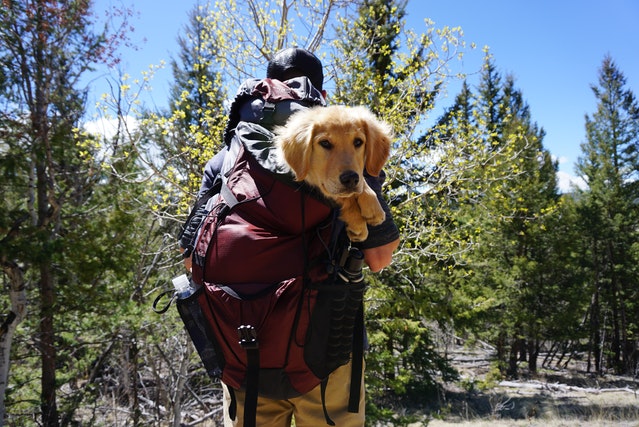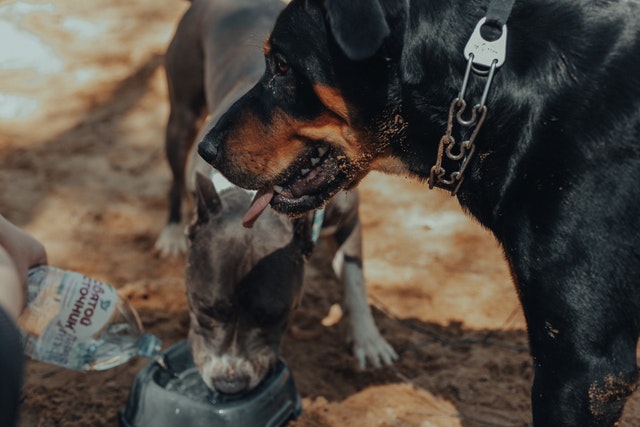Tips for Backpacking with Dogs
Posted: 11/06/2023 | BY: Content Writer | Categories: Uncategorized
Hiking is a fun activity that allows you to get exercise while enjoying the great outdoors. And the greatest hiking companions in the world usually have four legs and a tail that never stops wagging. But before you go backpacking with dogs, consider the following guidelines to keep your pup safe and healthy.

Check with Your Veterinarian
It’s always a good idea to take your dog in for a checkup before heading into the backcountry. This way your vet can make sure your dog’s vaccines are up-to-date and that they are overall healthy.
ID Tags and Microchipping
Though you will do your best to keep your dog safe and at your side at all times, things happen, and sometimes our furry pals can get off lead and lost. For this reason it is important to be sure your dog is wearing an ID tag with their name and your phone number clearly visible. It’s also important to have your dog microchipped because sometimes collars and ID tags can come off your dog.
Know Your Dog’s Limitations

Our pets are stoic and we don’t always recognize when they are in pain or uncomfortable. It’s important to watch your dog closely if the weather is hot, or if the hike is particularly challenging. Some signs of distress or pain can include lagging behind, limping, excessive panting or loud breathing. If you should notice any of these behaviors, allow your dog to take a long rest in the shade and offer them water.
Go Easy at First
If your dog is new to hiking, it’s a good idea to get them used to going on short hikes on easy trails. If your goal is to go on a multiple-day multiple-mile hike, work up to that goal slowly.
Know The Rules
It’s very important to pay attention to pet guidelines and regulations wherever you hike, because they can vary between locations. As an example, KOA campsites tend to have different rules than backcountry and wilderness hiking trails. And as a general rule, pets are not allowed on most rails within in National Parks. There are certain exceptions to this rule but in these areas there are heavy restrictions. So be aware.
Protect Their Paws

Do you know what the surface of the trail you will be hiking is made of? There are some surfaces, such as shale or lava rock, that are too rough or can get too hot for your dog’s unprotected pads. In these instances you will want to put special dog booties on your dog’s paws.
You’ve no doubt seen the funny videos of dogs trying to walk in these. Admittedly, dogs find walking in booties challenging at first, which is why you should allow plenty of time for your dog to get used to the booties before heading out on your first hike. If they simply refuse to wear protective booties, then it’s best to stick to dirt and grassy trails.
Watch for Dehydration
A dog’s body, like the human body, is mostly made up of water. And like humans, dogs can go a long time without food if necessary, but they require proper hydration to stay healthy.
It’s important that you remember your dog cannot sweat. To keep himself cool he must pant. It is the act of panting, and the evaporation of water, that cools him. This water will need to be replenished often. If your doh becomes dehydrated, he will not be able to cool himself properly.
Some signs your dog might be dehydrated are:
- Dry or cracked nose
- White or blue gums or tongue
- Sticky-dry gums
- Lethargy or confusion
- Glazed eyes
- Diarrhea
- Vomiting
- Difficulty breathing
Dogs require 8.5 to 17 ounces of water for every 10 pounds of body weight per day. So a 50 pound dog requires 42-84 ounces per day. Obviously a dog that is hiking and panting will need an amount at the top of that range, if not more, than a dog who is napping all day on the couch in an air conditioned house.

The best thing to do is, every time you feel thirsty and take a drink, get that portable bowl out and offer your dog a bit of water as well. It is better to give small amounts of water to your dog throughout the day, than allow them to gulp a bunch down while they are panting. Gulping water and panting, gulping water and exercising, and gulping water and eating can cause bloat in some breeds of dog. Better to be cautious.
Prepare a First Aid Kit
While preparing your own human first aid kit, be sure to prepare one for your canine companion. No matter how hard we try to reduce the risk of injuries, things happen, so it’s best to be prepared. Speak with your vet to understand what items should be included in your kit. He or she will most likely suggest packing gauze, tweezers to remove ticks, EMT gel to seal wounds, and a dig-safe antihistamine in case of a bee sting. You may also want to ask about canine-specific pain meds.
Final Thoughts on Backpacking with Dogs
Hiking with your dog is a wonderful way for you two to bond and stay in great shape. Just be sure you follow these guidelines so you can ensure your pup stays safe and healthy the entire time you are on the trail!
Here’s Another Way to Keep Your Best Furry Pal Safe and Healthy
As a pet parent, you’ll do whatever is required to keep your dog safe and healthy out on the trail. But sometimes even the best-laid plans won’t stop accidents and illness from happening. Your pup can sprain their ankle or slice their pad on a piece of glass someone thoughtlessly left behind. And that’s when the cost of emergency or multiple veterinary visits for your dog’s treatment can really add up.
Protect your pup – and your wallet – with a pet insurance plan that guarantees the best veterinary care without breaking your bank account. Some dog health insurance plans can reimburse you for up to 90% of your veterinary costs.
At Pet Insurance Review, we are committed to bringing you the best policies from the top pet insurance providers in the country. Simply get a free quote now, and let us do the rest!
Resources:
- 1. Reisen, J (2021). How Do Pet Microchips Work and Should My Dog Have One? Retrieved from https://www.akc.org/expert-advice/lifestyle/how-do-dog-microchips-work/
- 2. AKC Staff (2021). How to Know if Your Dog Is in Pain: Signs of Discomfort. Retrieved from https://www.akc.org/expert-advice/health/signs-that-your-dog-is-in-pain/
- 3. Retrieved from the National Park Service website: https://www.nps.gov/subjects/pets/index.htm
- 4. Rosenberg, K (2021). How much water should my dog drink? Retrieved from https://www.petsradar.com/advice/how-much-water-should-my-dog-drink
- 5. Cynthia Otto, DVM, PhD (2020). Hydrate Your Hound For Health. Retrieved from https://www.cesarsway.com/hydrate-your-hound-for-health/
- 6. Bell, J. (2003). Risk Factors for Canine Bloat. Retrieved from https://www.vin.com/apputil/content/defaultadv1.aspx?pId=11165&meta=Generic&id=3848657
Disclaimer
The information contained on this blog is intended for informational and educational purposes only and should not be construed as medical advice. It is not a substitute for professional veterinary care. Always consult with your veterinarian before making any changes to your pet's health care or treatment plan.
The authors of this blog are not veterinarians and do not claim to be experts in pet health. The information provided here is based on our own experiences and research, as well as information from reputable sources. However, we cannot guarantee the accuracy or completeness of this information.
We encourage you to do your own research and consult with your veterinarian before making any decisions about your pet's health.
Next post
The 5 Best Emotional Support DogsCompare top pet insurance providers plans.
Enter your dog’s age in years and months to calculate their age equivalent to human years.
Calculate your dog’s ageEnter your cat’s age in years and months to calculate their age equivalent to human years.
Calculate your cat’s age